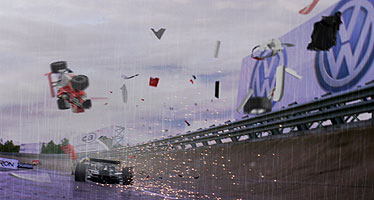|


TOLUCA LAKE, Calif. DRIVEN, the recently released Warner Bros. film directed by Renny Harlin, tells the story of four race car drivers chasing the ultimate adrenaline rush. To create some of the film's harrowing car crashes, too dangerous for any stunt person, Harlin turned to Toluca Lake, Calif.-based Pixel Magic. According to Ray McIntyre Jr., Pixel Magic's visual effects supervisor, the company provided visual effects for 50 shots in total, including two CGI car crash sequences. "We also created computer generated grandstands and populated them with computer generated people - shots where they had no grandstands and therefore did not have the ability to fill a grandstand with extras," said McIntyre Jr.
"Renny wanted something that no one has ever seen, because it's not possible to see it in the real world. What he wanted was an out-of-body experience for the driver that the audience gets to see," explained McIntyre Jr. "What the audience sees is this radical flipping car. What the driver sees is the world around him in slow motion trying to deal with the situation at hand." "It was originally intended for the crash to be practical and the cars around the crash to be computer generated. They shot in a test track in Montreal with a single car on the track being pulled by wires and then being pulled by a secondary wire in to the guardrail. They had eight or 10 cameras for that shot and the car was pulled into the guard rail; it nosed down, the tail went up in the air and it popped back down and did something very unspectacular. At that point they realized it's a very difficult thing to do. So they gave up on the idea and the crash became entirely CG," said McIntyre Jr. To create the out-of-body experience, Todd Vaziri, Pixel Magic's compositing supervisor, developed a custom transition. "You see the car go nose down tail up and come flying through the air. Then we do a transition that we call a slingshot transition designed by one of our artists here... to let you know there's this change in perspective. It starts with a wide shot and it starts to vibrate like something is about to happen. It shakes and does a little size change and then immediately pushes into the helmet of the driver in the race car. Then it pulls back out of that in the same fashion and now the world has changed. We are in slow motion. Even the rain. That transition signifies the change." Film & Video Magazine, May 2001, Short Takes
Pixel Magic's web page: http://www.pixelmagicfx.com |
